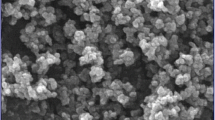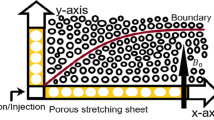Abstract
The present study investigates numerically heat transfer rate (HTR) and generation of entropy (GOE) for turbulent NF flow in an electronic cooler equipped with four sinusoidal pipes. The heat transfer fluid (HTF) is water-based MWCNT nanofluid (NF) in different NVFs (ϕ = 0.2, 0.4, 0.6 and 0.8%). Four different wave amplitudes (α = 2, 4, 6 and 8 mm), three different wavelengths (λ = 40, 60 and 80 mm) are studied in this paper. According to obtained results, the average Nusselt number (Nu) always increases by increase in wave amplitude or decrease in wavelength. Therefore, at α = 8 mm or λ = 40 mm the highest Nu value is achieved. Besides, Reynolds numbers (Re) variation has a significant influence on Nu distribution in tube and the Nu values always intensify by augmentation of Re. The optimum Reynolds number in thermal viewpoint is 11,000 and in second law viewpoint is 5000. Furthermore, therefore higher nanoparticles volume fraction (NVF) always leads to higher HTR in channel. But it also increases dynamic viscosity and pressure drop penalty in channel. The results of the models obtained from the neural network algorithm show that the variation of the Nusselt number with respect to the Reynolds number, wave amplitude and wavelength is mitotically so that heat transfer increases by increasing the amount of these three parameters. An increase in the wave amplitude leads to a 38% increase in the average Nusselt number and a 50% increase in the total Nusselt number. However, the effect of the wavelength is small. An increase in the wavelength results in an enhancement in the average Nusselt number by 6% and the total Nusselt number by 16%.






















Similar content being viewed by others
References
Hajatzadeh Pordanjani A, Aghakhani S, Afrand M, Mahmoudi B, Mahian O, Wongwises S. An updated review on application of nanofluids in heat exchangers for saving energy. Energy Convers Manag. 2019;198:111886.
Pordanjani AH, Vahedi SM, Aghakhani S, Afrand M, Mahian O, Wang L-P. Multivariate optimization and sensitivity analyses of relevant parameters on efficiency of scraped surface heat exchanger. Appl Therm Eng. 2020;178:115445.
Cheraghian G, Rostami S, Afrand M. Nanotechnology in enhanced oil recovery. Processes. 2020;8:1073.
Cheraghian G. Application of nano-particles of clay to improve drilling fluid. Int J Nanosci Nanotechnol. 2017;13:177–86.
Pordanjani AH, Raisi A, Ghasemi B. Numerical simulation of the magnetic field and Joule heating effects on force convection flow through parallel-plate microchannel in the presence of viscous dissipation effect. Numer Heat Transf Part A Appl. 2019;76:499–516.
Rostami S, Aghakhani S, Hajatzadeh Pordanjani A, Afrand M, Cheraghian G, Oztop HF, Shadloo MS. A review on the control parameters of natural convection in different shaped cavities with and without nanofluid. Processes. 2020;8:1011.
Vahedi SM, Pordanjani AH, Wongwises S, Afrand M. On the role of enclosure side walls thickness and heater geometry in heat transfer enhancement of water–Al2O3 nanofluid in presence of a magnetic field. J Therm Anal Calorim. 2019;138:679–96.
Cheraghian G. A new thermal method concept for IOR from oil reservoir using optimized in-situ combustion. In: 78th EAGE Conference and Exhibition 2016, Vol. 2016, European Association of Geoscientists & Engineers, 2016, pp. 1–3
Cheraghian G. Improved heavy oil recovery by nanofluid surfactant flooding-an experimental study. In: 78th EAGE Conference and Exhibition 2016, vol. 2016, European Association of Geoscientists & Engineers, 2016. pp. 1–5
Cheraghian G. Nanokomposit stabilisiert Bohrflüssigkeiten. Keram Z. 2019;71:25–25.
Giwa S, Sharifpur M, Meyer J. Experimental study of thermo-convection performance of hybrid nanofluids of Al2O3-MWCNT/water in a differentially heated square cavity. Int J Heat Mass Transf. 2020;148:119072.
Haghighi A, Shadloo MS, Maleki A, Abdollahzadeh Jamalabadi MY. Using committee neural network for prediction of pressure drop in two-phase microchannels. Appl Sci. 2020;10:5384.
Shadloo MS, Rahmat A, Karimipour A, Wongwises S. Estimation of pressure drop of two-phase flow in horizontal long pipes using artificial neural networks. J Energy Resour Technol. 2020; 142
Duangthongsuk W, Wongwises S. An experimental investigation on the heat transfer and pressure drop characteristics of nanofluid flowing in microchannel heat sink with multiple zigzag flow channel structures. Exp Therm Fluid Sci. 2017;87:30–9.
Alrashed AA, Akbari OA, Heydari A, Toghraie D, Zarringhalam M, Shabani GAS, Seifi AR, Goodarzi M. The numerical modeling of water/FMWCNT nanofluid flow and heat transfer in a backward-facing contracting channel. Phys B. 2018;537:176–83.
Javanmard M, Taheri M, Abbasi M, Ebrahimi S. Heat transfer analysis of hydromagnetic water–graphene oxide nanofluid flow in the channel with asymmetric forced convection on walls. Chem Eng Res Des. 2018;136:816–24.
Qiu S, Xie Z, Chen L, Yang A, Zhou J. Entropy generation analysis for convective heat transfer of nanofluids in tree-shaped network flowing channels. Therm Sci Eng Prog. 2018;5:546–54.
Osman S, Sharifpur M, Meyer JP. Experimental investigation of convection heat transfer in the transition flow regime of aluminium oxide-water nanofluids in a rectangular channel. Int J Heat Mass Transf. 2019;133:895–902.
Joseph M, Sajith V. An investigation on heat transfer performance of polystyrene encapsulated n-octadecane based nanofluid in square channel. Appl Therm Eng. 2019;147:756–69.
Ajeel RK, Salim W-I, Hasnan K. Influences of geometrical parameters on the heat transfer characteristics through symmetry trapezoidal-corrugated channel using SiO2-water nanofluid. Int Commun Heat Mass Transf. 2019;101:1–9.
Ajeel RK, Salim W-I, Hasnan K. Numerical investigations of heat transfer enhancement in a house shaped-corrugated channel: combination of nanofluid and geometrical parameters. Therm Sci Eng Prog. 2020;17:100376.
Kumar PM, Kumar CA. Numerical study on heat transfer performance using Al2O3/water nanofluids in six circular channel heat sink for electronic chip. Mater Today Proc. 2020;21:194–201.
Yang S, Ordonez J. 3D thermal-hydraulic analysis of a symmetric wavy parabolic trough absorber pipe. Energy. 2019;189:116320.
Ashorynejad HR, Zarghami A. Magnetohydrodynamics flow and heat transfer of Cu-water nanofluid through a partially porous wavy channel. Int J Heat Mass Transf. 2018;119:247–58.
Ma Y, Mohebbi R, Rashidi M, Yang Z. MHD convective heat transfer of Ag–MgO/water hybrid nanofluid in a channel with active heaters and coolers. Int J Heat Mass Transf. 2019;137:714–26.
Dormohammadi R, Farzaneh-Gord M, Ebrahimi-Moghadam A, Ahmadi MH. Heat transfer and entropy generation of the nanofluid flow inside sinusoidal wavy channels. J Mol Liq. 2018;269:229–40.
Vahedi S, Zare Ghadi A, Valipour M. Application of response surface methodology in the optimization of magneto-hydrodynamic flow around and through a porous circular cylinder. J Mech. 2018;34(5):695–710. https://doi.org/10.1017/jmech.2018.1.
Sajid MU, Ali HM, Bicer Y, Exergetic performance assessment of magnesium oxide–water nanofluid in corrugated minichannel heat sinks: an experimental study. Int J Energy Res. https://doi.org/10.1002/er.6024
Nemati N, Omidvar A, Rosti B. Performance evaluation of a novel hybrid cooling system combining indirect evaporative cooler and earth-air heat exchanger. Energy. 2021;215(Part B):119216.
Ding ZX, Qin FGF, Peng K, Yuan J, Huang S, Jiang R, Shao Y. Heat and mass transfer of scraped surface heat exchanger used for suspension freeze concentration. J Food Eng. 2021;288:110141.
Leong W, Hollands K, Brunger A. Experimental Nusselt numbers for a cubical-cavity benchmark problem in natural convection. Int J Heat Mass Transf. 1999;42:1979–89.
Sheikholeslami M, Jafaryar M, Ganji DD, Li Z. Exergy loss analysis for nanofluid forced convection heat transfer in a pipe with modified turbulators. J Mol Liq. 2018;262:104–10.
Ghalandari M, Maleki A, Haghighi A, Shadloo MS, Nazari MA, Tlili I. Applications of nanofluids containing carbon nanotubes in solar energy systems: a review. J Mol Liq. 2020; 113476
Shadloo MS. Application of support vector machines for accurate prediction of convection heat transfer coefficient of nanofluids through circular pipes. Int J Numer Methods Heat Fluid Flow. 2020
Rehman WU, Merican ZMA, Bhat AH, Hoe BG, Sulaimon AA, Akbarzadeh O, Khan MS, Mukhtar A, Saqib S, Hameed A. Synthesis, characterization, stability and thermal conductivity of multi-walled carbon nanotubes (MWCNTs) and eco-friendly jatropha seed oil based nanofluid: an experimental investigation and modeling approach. J Mol Liq. 2019;293:111534.
Al-Ansary H, Zeitoun O. Numerical study of conduction and convection heat losses from a half-insulated air-filled annulus of the receiver of a parabolic trough collector. Sol Energy. 2011;85:3036–45.
Arani AAA, Sadripoor S, Kermani S. Nanoparticle shape effects on thermal-hydraulic performance of boehmite alumina nanofluids in a sinusoidal–wavy mini-channel with phase shift and variable wavelength. Int J Mech Sci. 2017;128:550–63.
Sadripour S, Chamkha AJ. The effect of nanoparticle morphology on heat transfer and entropy generation of supported nanofluids in a heat sink solar collector. Therm Sci Eng Prog. 2019;9:266–80.
Baliga B, Patankar S. A new finite-element formulation for convection-diffusion problems. Numer Heat Transf. 1980;3:393–409.
Laghari IA, Samykano M, Pandey A, Kadirgama K, Tyagi V. Advancements in PV-thermal systems with and without phase change materials as a sustainable energy solution: energy, exergy and exergoeconomic (3E) analytic approach. Sustain Energy Fuels. 2020;4:4956–87.
Salari A, Kazemian A, Ma T, Hakkaki-Fard A, Peng J. Nanofluid based photovoltaic thermal systems integrated with phase change materials: Numerical simulation and thermodynamic analysis. Energy Convers Manag. 2020;205:112384.
Sadripour S. 3D numerical analysis of atmospheric-aerosol/carbon-black nanofluid flow within a solar air heater located in Shiraz, Iran. Int J Numer Methods Heat Fluid Flow. 2019
Acknowledgements
This work was funded by the Deanship of Scientific Research (DSR), King Abdulaziz University, Jeddah, under grant No. (DF-026-135-1441). The authors, therefore, gratefully acknowledge DSR technical and financial support.
Author information
Authors and Affiliations
Corresponding author
Additional information
Publisher's Note
Springer Nature remains neutral with regard to jurisdictional claims in published maps and institutional affiliations.
Rights and permissions
About this article
Cite this article
Abu-Hamdeh, N.H., Bantan, R.A.R., Nusier, O.K. et al. Numerical study and artificial neural network modeling of the tube banks arrangement considering exergetic performance. J Therm Anal Calorim 145, 2241–2259 (2021). https://doi.org/10.1007/s10973-021-10717-2
Received:
Accepted:
Published:
Issue Date:
DOI: https://doi.org/10.1007/s10973-021-10717-2




